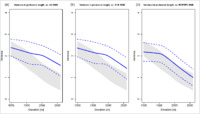Functional homogenization of bumblebee communities in alpine landscapes under projected climate change
- Pradervand, Jean-Nicolas Department of Ecology and Evolution, University of Lausanne, Switzerland
- Pellissier, Loïc Department of Biology Ecology & Evolution, University of Fribourg, Switzerland
- Randin, Christophe F. Botanisches Institut der Universität Basel, Switzerland
- Guisan, Antoine Department of Ecology and Evolution, University of Lausanne, Switzerland - Institute of Earth Surface Dynamics, University of Lausanne, Switzerland
-
22.10.2014
Published in:
- Climate Change Responses. - 2014, vol. 1, no. 1, p. 1
English
Background: Bumblebees represent an active pollinator group in mountain regions and assure the pollination of many different plant species from low to high elevations. Plant-pollinator interactions are mediated by functional traits. Shift in bumblebee functional structure under climate change may impact plant-pollinator interactions in mountains. Here, we estimated bumblebee upward shift in elevation, community turnover, and change in functional structure under climate change.Method: We sampled bumblebee species at 149 sites along the elevation gradient. We used stacked species distribution models (S-SDMs) forecasted under three climate change scenarios (A2, A1B, RCP3PD) to model the potential distribution of the Bombus species. Furthermore, we used species proboscis length measurements to assess the functional change in bumblebee assemblages along the elevation gradient.Results: We found species-specific response of bumblebee species to climate change. Species differed in their predicted rate of range contraction and expansion. Losers were mainly species currently restricted to high elevation. Under the most severe climate change scenarios (A2), we found a homogenization of proboscis length structure in bumblebee communities along the elevation gradient through the upward colonization of high elevation by species with longer proboscides.Conclusions: Here, we show that in addition to causing the shift in the distribution of bumblebee species, climate change may impact the functional structure of communities. The colonization of high elevation areas by bumblebee species with long proboscides may modify the structure of plant-pollination interaction networks by increasing the diversity of pollination services at high elevation.
- Faculty
- Faculté des sciences et de médecine
- Department
- Département de Biologie
- Language
-
- English
- Classification
- Biological sciences
- License
-
License undefined
- Identifiers
-
- RERO DOC 232993
- DOI 10.1186/s40665-014-0001-5
- Persistent URL
- https://folia.unifr.ch/unifr/documents/303948
Other files
Statistics
Document views: 140
File downloads:
- pdf: 245
- Supplementary material: 116

